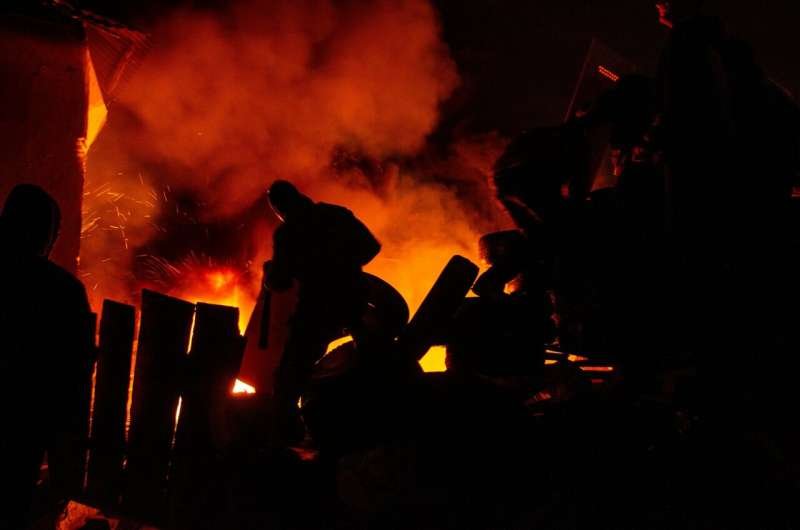
We live in an age of increasing wildfire disasters because more of us are living in places where wildfires and human development collide. Right now, fast-moving wildfires are forcing mass evacuations and destroying homes across Manitoba, Saskatchewan and British Columbia, where entire communities are under threat.
Despite the growing impacts of extreme weather events, including prolonged droughts and increasing temperatures, we continue building and even rebuilding homes in likely paths of destructive wildfires.
As cities grow, the demand for new home developments in previously forested areas means that we’re rapidly losing buffers between developed and natural land. Consequently, we’re also losing much of our protection from wildfire.
I’m a structural engineer, and I was living in British Columbia during the 2023 Kelowna fires. I remember the smoke and anxiety about what was coming next. Seeing news coverage of January’s fires in Los Angeles brought back those memories. Hearing people ask how this could have happened led me to ask in response: How could it not have happened?
My research specialty is in protecting structures from fires, earthquakes and explosions. From my work, I know that improved materials and engineering can protect homes much better than we do today.
As we enter another wildfire season in Canada, I worry there will soon be new reminders of what we still haven’t done and urgently need to do.
Wildfire risk
Wildfires can ignite structures in three key ways: direct fire flux from the forest, heat radiation from nearby burning buildings and wind-driven ember showers. These embers can travel several kilometers and spark new fires far from the main blaze.
Recent research shows that about 14.3% of all Canadian buildings sit directly in the wildland-urban-interface—the area where development neighbors or intersects with wildland vegetation. However, if we expand this interface buffer by a kilometer to account for windborne traveling embers, over 79% of all Canadian structures fall under some level of wildfire ignition risk.
While researchers are working on developing more sophisticated technologies for early fire detection and monitoring, we also need to make homes safer in at-risk areas. Programs like FireSmart Canada educate communities about managing fire risk, but broader public engagement and coordinated action are still lacking.
Primary hazards
Historically, structural design has not treated fire as a primary hazard in the same way it does earthquakes or wind. We’ve designed and constructed buildings and bridges that can withstand earthquakes and high winds, but fire design is still largely governed by prescriptive, often overly simplified, insulation and building standards.
This mismatch in design priorities introduces vulnerability. Just as we wouldn’t build in seismically active regions like Vancouver, Victoria or San Francisco without accounting for earthquake risk, or in flood-prone areas like Winnipeg or New Orleans without proper mitigation, we must begin to treat fire risk as an equally fundamental design consideration.
It’s certainly daunting to consider the expense of building or retrofitting homes and adapting properties to resist wildfires, but the consequences of not planning or preparing better—both in terms of lives lost and homes ruined and in terms of the financial costs of rebuilding—will only worsen if societies don’t do much more.
Alternative materials
It’s obvious that buildings at elevated risk from fire should not be made from combustible materials, like exposed timber. Now, there are impressive alternatives, such as new forms of concrete and metal roofing that can prevent fire from taking hold in a home, garage or other building.
Improved land-use planning and community-scale design can also meaningfully decrease the exposure and vulnerability of buildings to wildfire. What we need is a cohesive, risk-averse and data-driven framework that allows for architectural and structural design choices based on quantified fire risk.
Research—only if we make it a funding priority—can give us such a framework.
Enhancing safety
In Jasper, Alta., which is in a national park, new federal guidelines for rebuilding after last year’s devastating fire call for enhanced safety. These include new separations between buildings and flammable landscaping, including nonflammable buffers to separate homes from wooden fences and decks.
If we continue to build (and rebuild) within forest boundaries, we have to expand standards, mandates and engineering efforts to protect people and their homes.
How can we make them safer?
We can start with much-needed building code updates. And we can educate residents and home-buyers about reducing their risk.
FireSmart Canada, for example, offers practical advice on what kinds of trees, shrubs and lawns are safest to use in landscaping, and how far they should be from one’s house, depending on the degree of local fire risk. However, a more community-driven safety mindset is required for successful implementation of these guidelines; individual efforts alone are not enough to reduce the wildfire risk in interconnected neighborhoods.
For developers, designers and builders, improving safety may mean tighter new zoning rules and stricter building codes to govern where and how we build to protect against fire. Suppliers will need access to safer materials, some of which have yet to be developed.
Research priorities
To develop a framework, recommendations and guidelines to enhance fire safety and reduce loss, we need evidence, and that requires research.
In Canada, we have excellent researchers working on forest fires. But as a fire crosses from a natural setting to an urban one, everything changes—the fuel, wind patterns and movement of the fire—so we need to study and model it differently too.
These forms of knowledge are all within reach, but until we prioritize them, we are deciding to put lives and neighborhoods at risk. The price of doing nothing will be much greater than the cost of taking action.


